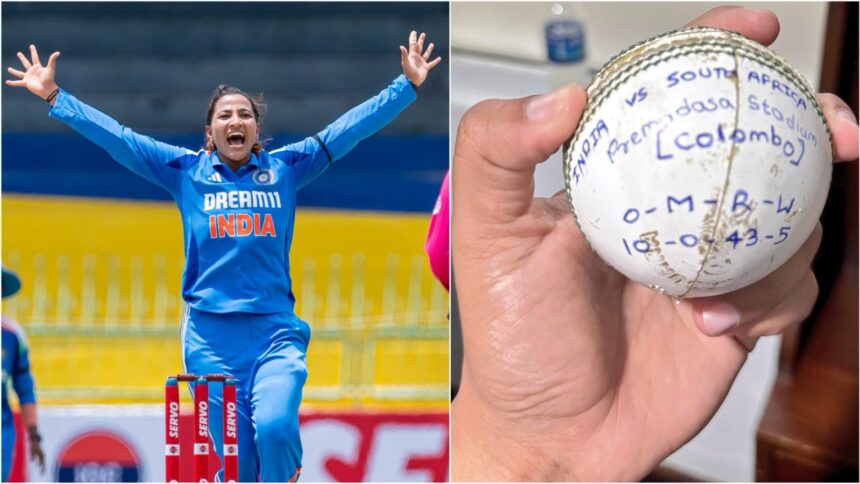“I will not give up, that’s my mantra.” That was Sneh Rana’s response when she was asked about what’s key to making one comeback after another. As she collected her player-of-the-match award in Colombo on Tuesday after a five-for against South Africa in the Tri-Series, that sentiment rang true. It cannot be easy being Sneh Rana, often in and out of the national side, performing when opportunities come her way one day, finding herself out of reckoning on another. India have a problem of plenty when it comes to picking right-arm offspinners, that’s part of the Rana puzzle, but with her start to this Tri-Series – 3/31 and 5/43 – she has made a strong statement to the selectors and team management.
She was perhaps the more deserving recipient of the PoTM award on Sunday against Sri Lanka too, because the bowlers did more than the batters in a low-scoring match. But there could have been no arguments over the decision on Tuesday. In a match where South Africa were in control of the run-chase for nearly 40 overs, it was one over from Rana that decisively swung the pendulum in favour of India. Chasing 277, South Africa were being propelled by a sensational century from Tazmin Brits and a useful lower-order hand from Annerie Dercksen. Rana dismissed both those batters in the 48th over that also included the wicket of Nadine de Klerk. The result was a first five-wicket haul in ODIs for Rana, and a 15-run win for India.
“Playing after a long gap, it means a lot to me,” Rana told broadcasters after the first match. “Going there, performing well for your country… I just want to say that never give up on your dreams and have patience. Good things take time, but they definitely come.” Her post on X, with a white-ball that had her bowling figures written on, read: “Mehnet ka fal aur samasya ka hal der se hi sahi magar milta zaroor hai. (The fruits of hard work and solution to the problem are definitely received, even if late).”
At the 40-over mark, there was nothing to separate the two sides. Opting to bat first, India had reached 195/3 during their innings. In reply, South Africa were 196/3. While India took a more sedate approach to reach that point, South Africa had gotten off to an absolute flier thanks mainly to Brits’ blitz in the powerplay. But India’s spinners had started to claw things back in the middle overs, and, central to it was Rana, rookie Sree Charani and Deepti Sharma’s control of length. Deepti provided the first breakthrough in the 28th over by trapping Laura Wolvaardt in front. At that point, the required rate was just above 6 runs per over. By the 40th, that had gone up above 8.
Key to Rana’s five-for was the variation of pace. It is a telling stat that out of the eight wickets she has taken in the two matches in this series, three have been caught-and-bowleds. And two, where the batters have looked to come down the track and hit her over midwicket along with the spin – a good ploy – but finding themselves not reaching to the pitch of the deliveries. Both signs that she had been able to achieve the primary objective most spinners set out to: deceive batters in the air. “I was just thinking about my variations, the pace-off deliveries worked really well. That was the discussion with the management and glad it worked well,” Rana said.
With the bat, India’s 276/6 was a mixed bag, and on another day, their lack of intent during various phases could have come back to bite them. Pratika Rawal’s sensational start to ODI career continued as she notched up her sixth 50+ score in eight matches. Harleen Deol’s slow starts are a problem India must address sooner rather than later, with all of India’s top four currently built in a similar mould of using up deliveries to get their eye in. India’s late surge to 276 was possible because of a couple of stroke-filled cameos from Jemimah Rodrigues and Richa Ghosh.
Brief scores: India 276/6 (Pratika Rawal 78, Jemimah Rodrigues 41, Nonkululeko Mlaba 2/55) beat South Africa 261 in 49.2 overs (Tazmin Brits 109, Sneh Rana 5/43)








